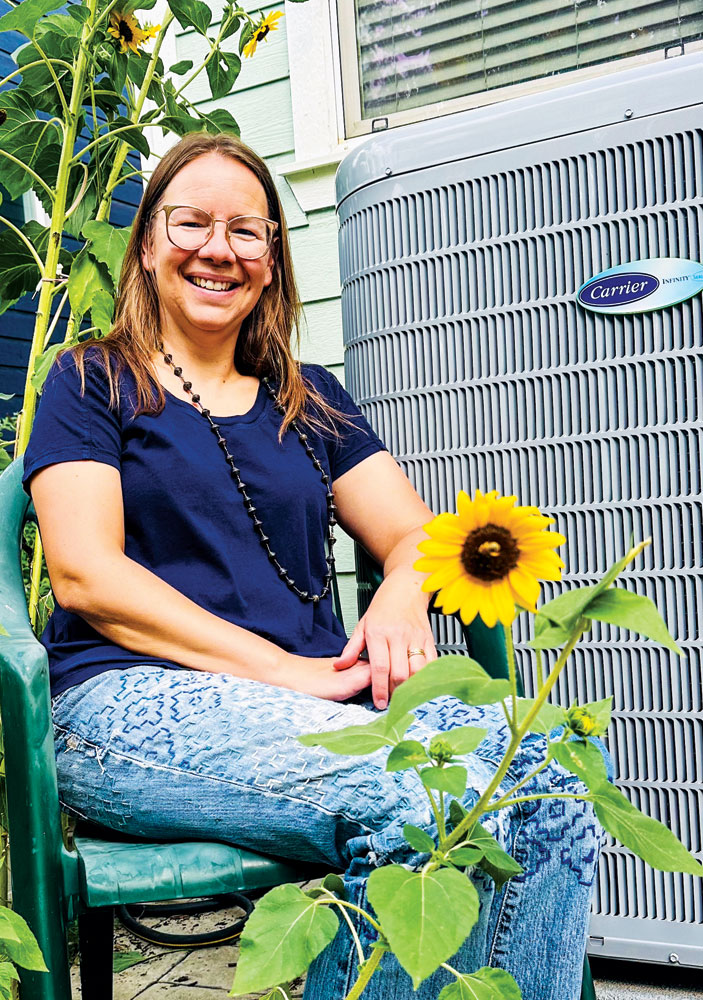
Educator and writer Christina Foust sits next to the family’s new heat pump in the backyard of her Central Park home surrounded by volunteer sunflowers. Front Porch photo by Christie Gosch
Having taught Environmental Communication for over two decades now, I find myself in frequent conversation about climate change. I’ve noticed a shift over time. The upside is that I spend less time educating (or, in worse cases, persuading) students about greenhouse gases, rising surface temperatures, and the unpredictable climate effects they are wreaking and will continue to create. But the hard part is the sense of hopelessness that many people feel. Like other “wicked problems,” climate change presents no easy answers. Couple this with politics and power that make it difficult to agree on the problem, and it’s no wonder many people feel resigned.
My hope with this new Green Simple Living column is to share ideas to help Front Porch readers make a good faith effort to respond to climate change. The ideas will vary in resources, especially their cost and the time they require. But behind each of them is the hope of scaling up practical actions for more benefit and less harm to people and the planet. We begin with heat pumps.
I live in a 20-year-old home in “classic” Central Park. Two winters ago, the heater stopped working. Fortunately, our repairperson found it was a simple fuse, but warned that the furnace itself could go at any time. I had learned about heat pumps from a neighbor.
The pumps, which come in a variety of sizes, are basically like big air compressors that pull and push air, maintaining a constant temperature in the house. Unlike forced air systems that blow warm air into the house until it reaches 68 degrees, the heat pump removes cold air and warms it inside a heat sink, then moves that back to the house. As we’ve learned over the 9 months since installing ours, the heat pump can be like a mystery machine in the backyard, sighing and whirring with longer bursts of activity, or sitting silently. But in its workings, it is 3-5 times more energy efficient than a natural gas furnace per the International Energy Association. This means that more of the power used to heat our home is going into actually heating it.
There are issues with any electricity generation, including renewables. But as a 2024 study by the National Renewable Energy Laboratory (NREL) found, even if heat pumps run on a “dirty” (fossil fuel) fired electricity grid, they will lower household emissions, on average, 36-64%. For those of you doing calculations, heat pumps save 2.4-4.4 metric tons of CO2 per year, per home—not quite the average of 4.6 metric tons emitted by your average passenger vehicle in a year, but still, a significant dent.
With natural gas prices fluctuating but trending higher, heat pumps save money by heating homes through electricity rather than gas—roughly 30-40% (or $460 per year) for an average homeowner living in colder climates, per the US Department of Energy. Why lock in another 20 years with an inefficient system that relies on natural gas alone? Tax credits and Xcel Energy rebates are available to help replace dying furnaces with heat pumps. Imagine the impact this could make.
We may not have a manual on how to transition toward a greener future, but fortunately, we have a lot of people making good faith efforts right now. As we’ve learned through the Covid-19 pandemic, it matters when individuals and households change their ways. I remember following our neighbors’ lead, allowing kids to play on the porch after they had a pump of hand sanitizer. But when new routines scaled up to include our neighborhood, our city, our state, and beyond, we could see the difference they made. As scientists predicted, large gatherings of people indoors, particularly unmasked, led to surges in cases reported. We adjusted by trying masks, social distancing, and other techniques that we might debate today. This recent memory shows us the potential of acting together in the face of uncertainty
Cristina Foust is a professor of Communication Studies at MSU Denver, and co-founder of the Westerly Creek Elementary School Green Team. Email her at cfoust2@msudenver.edu or reach out on Facebook. Her column Green Simple Living will appear periodically in Front Porch.




Great article. I will be looking into a heat pump now.